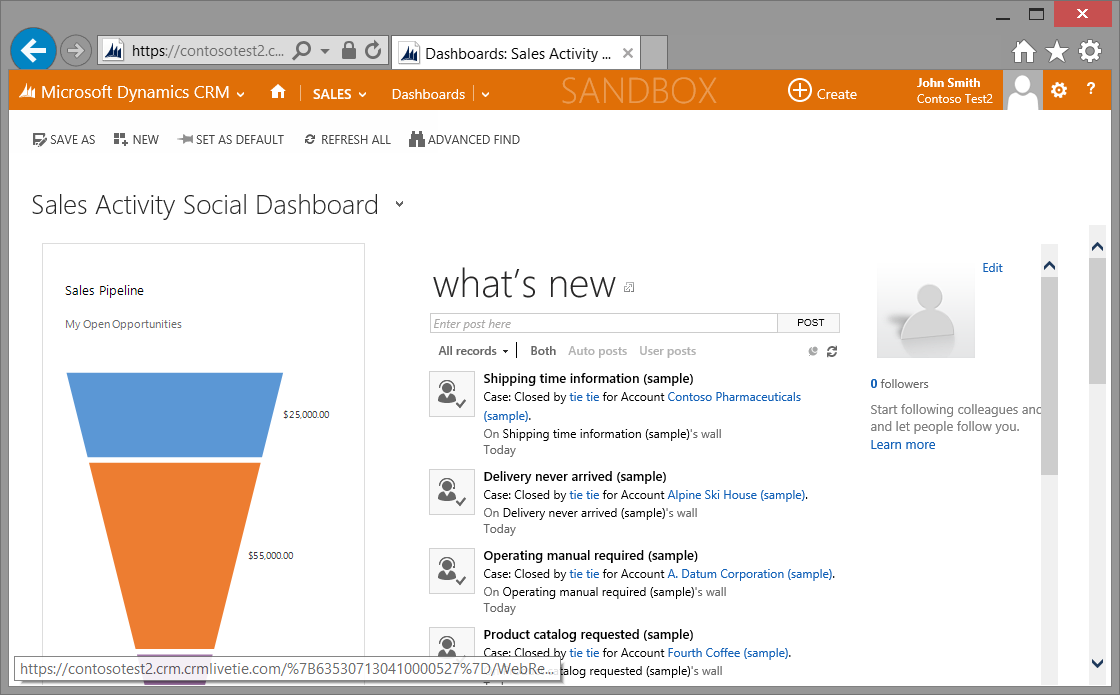Introducing Sandbox Instances in CRM Online
You may have noticed changes to the navigation bar at the top of one or more of your Dynamics CRM Online instances. For both free and paid test instances, you’ll now see an orange navigation bar with a SANDBOX watermark. Production instances will continue to display the blue bar you’ve come to expect. This post covers what this change means to you and how this relates to some new capabilities we’ll be releasing in the near future.
Changes to Non-production Instances
Dynamics CRM Online 2013 introduced the concept of non-production, test, instances. These instances could either be purchased as an add-on to your subscription or you would be granted a single free non-production instance if you purchased 25 or more user licenses for CRM Online. Since they are either purchased at a considerable discount from additional production instances or free, these instances may only be used for non-production purposes. Earlier this year we published a thorough blog post introducing test instances.
Up until now, the only noticeable difference between a production and non-production instance was the instance type displayed on instance’s edit settings page in the CRM Online admin center. The type displayed was either Production instance, Paid Test instance, or Free Test instance, depending on how it was obtained. The type is set when an instance is provisioned and can’t be changed by a customer administrator.
The most recent change amounts to the following:
- Free Test instance and Paid Test instance types have been renamed Sandbox instance. See the edit settings page in the CRM Online admin center:
- When you sign into a Sandbox instance, you’ll see the orange nav bar and SANDBOX watermark:
We’ve made this change to ensure that end users know when they’ve signed into a sandbox instance and do not make production changes by mistake.
Other than the changes mentioned above, there are no functional differences between production and sandbox instances. You can perform all of the customization, development, and testing work in a sandbox instance without concerns that the experience will be different in production.
Welcoming Sandbox Instances to CRM Online
These changes are part of a much larger wave of improvements we are making in Dynamics CRM Online to better support enterprise application development.
Your mission critical business applications run on Dynamics CRM Online and all changes must be managed carefully. Without the proper development time, evaluation, and testing, the stability of your application may suffer and result in unnecessary downtime that could have been avoided by making these changes elsewhere. The ideal place to develop and test new application change is a Sandbox instance that is isolated from your production application.
We don’t treat the running Sandbox applications any differently from Production instances. They are both given the same level of resources and support. By design, though, your Sandbox Instance application database is completely isolated from production. It may contain a full or partial copy of production data, users, and customizations. Since changes in a Sandbox Instance do not affect production, you can build your applications with the confidence that their daily productivity will not be adversely affected.
In the near future, we’ll release additional capabilities to the CRM Online admin center that target Sandbox instances exclusively.
Reset Instance (RESET)
Delete the instance completely and re-provision from scratch. This is particularly useful when you are starting a new implementation or have completed a project and you’d like to free up the resource consumed by a large sandbox instance.
Copy Instance (COPY)
Make a copy of an instance into a sandbox. You can copy either a production or sandbox instance, but the target must be a sandbox. There are two types of copies you can perform:
- Full Copy
Copy the full application database from the source to the target. This make an exact copy of the source instance, including all application data, users, customizations, etc. You’ll need to make sure you have enough available storage space to copy before you copy the instance.
- Minimal Copy
Copy only the customizations, core configuration data, and users from the source to the target. This is primarily useful for development scenarios when the full production database is not needed. You will need to import your custom configuration and sample data to complete the process.
Administration Mode (ADMIN)
Even though the production and sandbox databases are isolated from each another, you may have customizations that reach out to external services. Without updates to these connections, you could inadvertently perform operations in a production service while working in a sandbox instance. We’re introducing a new administration mode for sandbox instance to reduce the risk of production impact. When you perform a copy operation, for example, the target sandbox instance is placed in administration mode. After the copy is complete, the admin will have an opportunity to resolve any issues in the sandbox instance before bringing the instance fully back online.
- Enable Administration Mode
Only users with the System Administrator or System Customizer role can sign in at this time. This allows an admin to lock out end users and give them a chance to make customization changes without having end user signed into the system.
- Disable Background Operations
Sometimes, even with no users signed into the system, asynchronous operations may result in your CRM application reaching out to an external service. With this mode enabled, all asynchronous operations will be cancelled. This includes workflows, sending email, Exchange sync, and Yammer.
- Custom message for end users
This text will be displayed to end users when they attempt to sign in. Admin can use this to provide more information on what is going on in the sandbox instance and when the instance is expected to be available.
Between these new sandbox admin capabilities and our rich development tools, we are making it easier than ever before to build, test, deploy, and maintain your Dynamics CRM Online solutions. Keep an eye on this blog for announcements of future updates to your CRM Online administration experience.
Mike Carter and the Dynamics CRM Online Services product team






